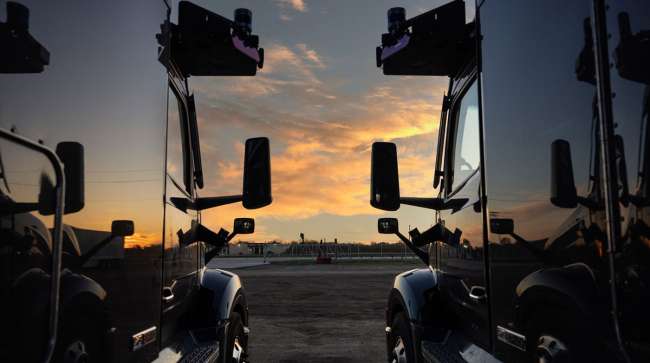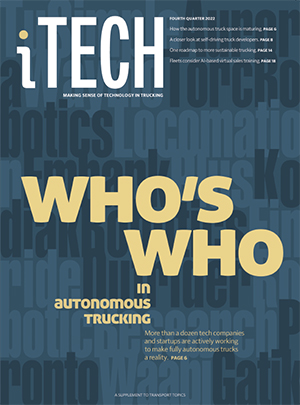Senior Reporter
Aurora Details Financial Plan, Unveils Lidar Breakthrough

[Stay on top of transportation news: Get TTNews in your inbox.]
Autonomous technology developer Aurora Innovation says a new round of public and private funding of at least $800 million to $820 million means it will have enough money to launch its system of self-driving vehicles and other technology components next year.
Pittsburgh-based Aurora said in a regulatory filing that it plans to sell $600 million in common stock through a private placement, and further offer up to $200 million of common stock in a public offering. The company also said it had an additional $785 million in cash on hand as of the end of last month. Combined with the new fundraising, it will have as much as $1.5 billion available in cash, cash equivalents and short-term investments.
In a blog post, CEO Chris Urmson called it an “awesome day for the self-driving industry and the company.”
He added Aurora now is in a strong financial position for at least the next 18 months to two years.

Urmson
“This huge amount of funding gives us the runway through next year’s expected commercial launch and well into 2025,” he said. “We are fortunate to have incredible partners in the capital markets.
“Throughout Aurora’s history and in this most recent fundraise, we have had incredibly strong support from top-tier institutional investors, both existing and new, as well as strategic partners. The backing of these investors is a testament to our progress and potential.”
In the past, Aurora has collaborated with several well-known vehicle manufacturers including Paccar, Peterbilt, Kenworth, Volvo and Toyota, and freight companies FedEx, Werner, Schneider, Uber Freight, Ryder, U.S. Xpress and Covenant.
Urmson says the funding is further evidence that Wall Street believes in the direction the company is going.
We’re excited to announce we’ve successfully raised $820 million in an equity funding round. These additional funds will help our continued work to shape the future of accessible, safe, and efficient transportation.
Learn more about this incredible time at Aurora, and how we’re… pic.twitter.com/hzypEKv5aw — Aurora (@aurora_inno) July 21, 2023
“Remaining an independent or stand-alone company — unlike many of our peers — gives us the operational freedom to focus on our mission, and not be redirected or distracted by competing business priorities,” he said. “This has positioned us to advance quickly toward product deployment while others unfortunately waver.”

Who's Who in the Autonomous Space
►Overview of Self-Driving Truck Development
Company Sketches
Click the links to jump to profiles of autonomous companies.
Aurora | Waymo | TuSimple | Gatik | Locomation | Torc Robotics | Waabi | Einride | Plus | Embark | Kodiak Robotics | Robotic Research | Outrider | Pronto
The company said in a regulatory filing it expects to spend $175 million to $185 million per quarter, ahead of a commercial launch expected by the end of 2024.
As Aurora unveiled its financial plan to reach that target date, the company also explained its latest technical development that it says will help get the technology into more trucks sooner.
Aurora introduced the integrated optical components of its proprietary, long-range lidar radar sensors and the semiconductor chips the company said will improve the radar systems’ functionality.
Aurora has branded this technology FirstLight Lidar. The lidar-on-chips were derived from the technologies of two lidar startups that Aurora acquired in 2019 and 2021. The technologies have now been combined on a single chip, which the company said can unlock the mass manufacturing of the sensors that can allow trucks to detect and identify obstacles at an industry-leading range of as much as a quarter of a mile on highways.

Barber
“We’ve integrated FirstLight’s discrete optical components into a series of semiconductor chips. For the first time, we’ve demonstrated the functionality of each chip component and have confidence that these chips will come together in an end-to-end system that delivers a range and functionality more powerful than our current generation of FirstLight Lidar,” Zeb Barber, Aurora’s senior director of Lidar Research and Development, said in a blog. “By harnessing the power and innovation of integrated photonics, we’ve charted a viable path toward an increasingly scalable generation of FirstLight Lidar.”
Aurora says its long-range Frequency Modulated Continuous Wave lidar is critical to unlocking safe, driverless operations at highway speed and is vastly superior to traditional Amplitude Modulation lidar, which is used for short-distance sensing in driver assistance and self-driving systems.

How effective have third-party services proved to be for fleets? Let's find out with Michael Precia of Fleetworthy Solutions and Dan Rutherford with Summit Virtual CFO by Anders. Tune in above or by going to RoadSigns.ttnews.com.
Think of terrestrial radio and the significantly improved audio quality from an FM radio station compared with the older AM technology, which can be full of static and electrical noise from outside sources.
AM lidar has a range of a couple of hundred yards, and the signal can be interfered with by a wide variety of sources. FM lidar sends out a constant stream of laser light that changes frequency at regular intervals and is less likely to have outside electrical interference.
Company officials compare the two systems to the amount of light generated by a flashlight versus a floodlight.
Aurora said with this latest development it expects to have a prototype of the lidar-on-chips by the end of the year, and the next-generation sensor suite could be in some trucks beginning in 2027. That’s about the time Aurora says it will begin mass production of its self-driving systems in a partnership with global supplier Continental.
“Much like the computer chip led to the proliferation of personal computers, the same applies to the manufacturing of lidar technology at commercial scale,” Barber said. “Our lidar-on-a-chip solution makes FirstLight Lidar more compact and reliable, faster and easier to build, and more affordable to produce.”
Want more news? Listen to today's daily briefing below or go here for more info:




